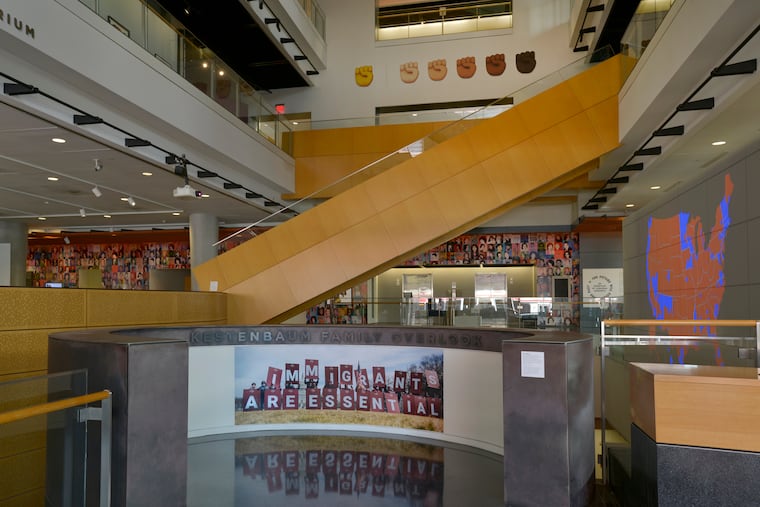Marilyn Monroe, Freud, Einstein, and Kafka are all at the Weitzman National Museum of American Jewish History
Jewish artist Jonathan Horowitz has assembled a motley crew of friends and art history heavyweights like Norman Rockwell, Ben Shahn, and Andy Warhol.

Jonathan Horowitz got the keys to the museum, and he brought his friends along.
The Weitzman National Museum of American Jewish History has given Horowitz curatorial carte blanche across its sprawling four-story building. The New York-based artist stationed his own work throughout the museum’s permanent collection as a way of commenting on a post-2020 world in the context of Jewish American history. Also along for the ride: art history heavyweights like Norman Rockwell, Ben Shahn, and Andy Warhol.
Horowitz, who identifies as a gay Jewish man, also showcases work from his art-world peers, a diverse group (stylistically and demographically) that comments on topics like Indigenous land and Black liberation.
The resulting show, “The Future Will Follow the Past,” is on view through 2023.
Founded in 1976, the Weitzman surveys nearly four centuries of Jewish history in America. This often means looking at the wider story of U.S. history through a Jewish lens, and exploring universal themes — immigration, xenophobia, intolerance — foundational to the Jewish diaspora.
Horowitz’s work includes political statues, self-referential sculptures, and an American flag painted in glitter.
First up is a wall full of Warhol: not a Jewish artist, but an artist who painted a lot of Jewish people. Horowitz assembled all of these portraits, 102 in total, into a colorful checkerboard of famous faces. There’s Freud, Einstein, Kafka, and Jesus. And Marilyn Monroe (who converted after her marriage to Arthur Miller).
“For most of the subjects, their Jewish heritage is invisible or negligible as part of their public personas,” Horowitz has said about this piece of wallpaper art. “So the piece is in part about assimilation, which I think you have to address when you’re talking about antisemitism.”
Upstairs, Horowitz has hung several large-scale works onto the walls.
Power (2019), a row of extra-large emoji hands printed on PVC board, shows six hands formed into fists: starting with the default emoji skin tone (Simpsons yellow), followed by five shades of light-to-dark pigment. Empowering, yes, but what if it’s also unsettling? Says the title card: “a dangerous suggestion can be read into the menu: that white nationalism is as legitimate a cause as the fight for civil rights.”
One floor up, Horowitz invokes Ellsworth Kelly with Pink Curve (2010), which samples its shape from Kelly’s 1993 sculpture series Memorial. Commissioned by the United States Holocaust Memorial Museum, Kelly carved long white panels into triangles with an arabesque curve for their long side. Horowitz doused his Kelly-inspired sculpture in fuchsia paint, a reference to the pink triangle badge assigned to gay men in Nazi Germany.
Horowitz’s showstopper is a slow build, but worth the wait. Untitled (August 23, 2017–February 18, 2018, Charlottesville, VA) is a bulging black sculpture that first appears to be awkward and in the way. But then we see the contour of a human head, then a horse’s head, then the curled front leg of the horse. Horowitz has remade, in a roundabout way, the incendiary monument of Robert E. Lee in Charlottesville, Va. — the one at the center of 2017′s “Unite the Right” rally where a white nationalist killed 32-year-old Heather Heyer — and draped it with a black tarp.
As for Horowitz’s featured guests: Packing the most punch is Never Forget, an enormous glossy photograph by Indigenous artist Nicholas Galanin. The words “INDIAN LAND” stand boldly in a Hollywood-style sign installed in a desert panorama of Southern California, the ancestral home of the Agua Caliente Band of Cahuilla Indians.
Elsewhere in the museum, Collier Schor’s photograph of lesbian activist Karla Jay and her partner hangs in the contemporary history wing. In a hallway between galleries, Horowitz has invited four living artists to respond to Norman Rockwell’s Four Freedoms (1943).
You can visit the museum for free on Friday, Saturday, and Sunday between 10 a.m. and 5 p.m. Free drop-in tours from 11 a.m. to 2 p.m. are subject to docent availability. The gift shop is fun — grab a pair of Freudian slippers — and open seven days a week.